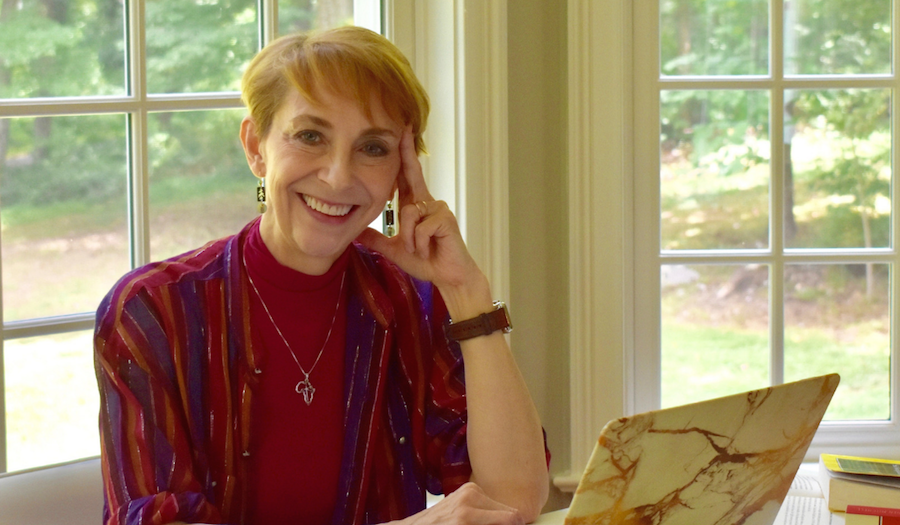What You Need to Know to Age Beautifully

I was lying on the floor with my eyes closed, diligently practicing a yoga posture called shivasana (“corpse pose”). Some say that this is the hardest to master, but I thought I was doing pretty well. Not to boast, but yoga teachers often take me for dead no matter what pose I’m attempting.
Anyway, as I lay there a random idea came to me. “How strange,” I thought, “that this body had three children.” Then I realized that it actually hadn’t. Since all our atoms are replaced every seven years, not an atom of the body I have now was present when my children were born.
Maybe this is the point of shivasana, because in that moment my self-concept suddenly shifted. I no longer felt that I was my body. Instead, I felt myself to be a point of awareness, constant through time. By some unfathomable magic, this wisp of identity causes clusters of atoms to organize themselves around it in a predictable pattern. My body wasn’t there when my children were born; my consciousness was.
We are all seven
If you think about it, that perpetual turnover of atoms technically means that no one’s body—not yours, not mine, not anyone’s—is ever older than seven. But in that case, why do we age at all? Why do our always-seven-year-old bodies wrinkle and sag so inevitably as the years go by?
Apparently, whatever force connects consciousness to matter has a plan, one that makes our bodies age predictably over time. But after that moment in yoga class, I started paying more attention to how it works. It turns out that the way our bodies change over time is strongly influenced by how we expect to age. Psychologists, anthropologists, and neurologists are finding that aging is heavily influenced by ideas attitudes, and mental habits.
In other words, we are active participants in our own aging. As researchers continue to find evidence for a strong mind-body connection, it seems increasingly likely that our thoughts and assumptions help shape the way we age.
Matter follows mind
Consider, for example, a study conducted by Harvard psychologist Ellen Langer. Langer and her colleagues invited a group of men in their seventies to live for a week in a converted monastery. The men arrived looking frail and stooped, many using canes or needing assistance with their luggage. Half the men spent the week just hanging out and reminiscing about their younger days. The other half went into a three-dimensional time capsule.
In the time-locked part of the building, the researchers had recreated an environment straight out of 1959. The furniture, the songs playing on the radio, the magazines lying around, were all from 1959 or earlier. No one was allowed to talk about anything that happened—in their private lives or in the world—after that year. There were no mirrors or family photos to remind them of their age; for that week, they were in 1959.
Seven days later, both the control group (the ones who sat around chatting) and the men in the time-warp showed increases in “physical strength, manual dexterity, gait, posture, perception, memory, cognition, taste sensitivity, hearing, and vision.” But the men in the time capsule had much more significant improvement, performing better on multiple tests of cognitive and physical strength. On the last day of the study, the men who had limped cautiously into the building a week earlier played a spontaneous game of touch football on the lawn.
In another well-known study, people were asked to solve “word jumbles,” groups of words that could be rearranged to form meaningful sentences. Some of the subjects were given sentences full of words related to negative stereotypes of aging, such as “old,” “wrinkled,” and “gray.” When these people left the laboratory, they walked more slowly than those whose jumbles didn’t contain such words.
If just looking at words has an immediate, observable effect on our physical vigor, how must our entire mindset be reflected in our bodies, day after day after day?
Epidemiologist David Snowdon is trying to answer that question by studying groups of Catholic nuns over long periods of time, testing physical and mental functioning over years and analyzing the nuns’ brains after they die. Nuns, who dedicate their lives to service and compassion, live longer than most people and are happier and more vigorous in later years. Most surprisingly, some nuns showed no signs of cognitive decline even though their brains proved to have advanced Alzheimer’s disease. Apparently, the brain and cognition may not be as closely linked as we think.
These studies and many others suggest that aging is based partly on mental outlook, behavior patterns, and cultural learning. We age the way we’ve been taught to age. And unfortunately, our culture teaches us to age miserably.
We’re set up to age badly
Dr. Mario Martinez is a clinical neuropsychologist and also a cultural anthropologist. Western medicine, he says, trains us to believe that aging is the same thing as progressive bad health. That isn’t necessarily true.
“Gerontologists have studied, intensely, the pathology of aging,” says Martinez, “but they know very little…about the wellness of aging.” In other words, Western medicine examines diseases that occur as we get older and calls the compilation of those diseases “aging.” But there has been very little research focused on people who get older without significant disease.
I have a friend who differentiates between “elders” (aging people who increase their capacity for wisdom and compassion over time) and “olders” (aging people who become more unhappy and bitter as the years go by). Our culture, with its focus on pathology and failing health, teaches us to be “olders.” We see and hear less about the elders, people who use advancing age as an opportunity for continuous personal growth.
The mindset of healthy aging
Mario Martinez interviews centenarians (people who live to be over 100 years old) all over the world. He’s found that they share certain patterns of thought and action, which can be learned at any time in life.
Here are a few hints from these healthy centenarians:
- Elders don’t obsess about strict health rules, such as rigid diet or exercise regimens. Instead, they put an unusual degree of focus on enjoying activities like eating and moving. In fact, their whole lives revolve around the experience of enjoyment.
- Elders engage in daily rituals that mark experiences as special: sipping a glass of brandy every night, gathering with others for meals. The content of the ritual isn’t the point: the practice is. Whatever they revolve around, enjoyable daily rituals are good medicine.
- Elders do what they love and never retire. Their daily work often involves service to other beings: people, animals, even plants. It never occurs to them to stop doing these things at a particular age.
- Elders live in the present while planning for a happy future. For example, some centenarians love gardening, with its quiet intensity of presence. They also made comments like, “This will look even better in ten years!”
- Elders are They don’t much care what they’re expected to do; they follow their interests, creating lives that are highly individualized. Perhaps this is why they don’t age and die the way they’re “supposed to.”
Practicing agelessness
To change our patterns of thought around aging, Martinez recommends a simple practice. When you have a few minutes to yourself, take time to relax, breathe deeply, and scan your body for areas of tension. Don’t try to relax them; just witness them (it’s the witnessing, not the trying, that creates relaxation).
Once you’re relaxed, repeat in your mind the thought, “I am ageless.” After several repetitions, notice any thoughts or places in your body that seem braced against this statement. Breathe into these points of tension while dropping your shoulders and relaxing your face. Then go back to mentally repeating “I am ageless.”
This was the concept that found me that day on the floor while I did the yoga version of playing dead. The part of me that has been with me my whole life is, in fact, ageless. The part of you that remembers the distant past—anything seven years ago or more—is ageless too. If you begin cultivating its wisdom, turning your attention away from what you’ve been taught about aging and onto what the elders can teach, you may just live a lot longer—and never be any older.
This essay was featured in the Oct. 27th edition of The Sunday Paper. The Sunday Paper inspires hearts and minds to rise above the noise. To get The Sunday Paper delivered to your inbox each Sunday morning for free, click here to subscribe.
